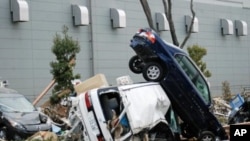Significant aftershocks continue to shake Japan, more than two months after the magnitude 9.0 earthquake that triggered massive tsunami, leaving 25,000 people dead or missing and creating a catastrophe at a coastal nuclear power plant.
Five tremors in excess of magnitude 5.0 on the Richter scale have shaken Japan just this week. But scientists are warning that the largest expected aftershock has yet to hit. And, new, devastating inland quakes can also be expected.
Japan hopes to never again hear these chilling words. An NHK announcer describing the scene on March 11 as a huge tsunami washes away homes, fishing trawlers and vehicles in coastal communities.
But scientists are cautioning that a repeat for Japan - on a smaller scale - is not a matter of if, but when.
After analyzing the magnitude 9.0 quake, scientists in Japan and the United States are making that sobering conclusion.
Several studies indicate the descending Pacific Ocean plate and the overlying plate on which Japan sits, slipped past each other by up to 60 meters. The research indicates five portions of the fault - covering more than 600 kilometers - were ruptured in the quake. That forebodes more seismic activity.
And, because the March 11 quake seems to have transferred stress along the same fault, some scientists are cautioning about a magnitude 8.0 closer to the Tokyo metropolitan area, home to more than 30 million people.
However, others offer a wider geographical target, as far to the north as Hokkaido.
A frequently cited time frame, by some of Japan’s most senior seismologists, is between now and the next ten months.
However, professor Takeshi Sagiya at Nagoya University’s Research Center for Seismology, Volcanology and Disaster Mitigation is cautious about that narrow chronology.
"I'm not quite sure about the basis of those specific kind of prediction about aftershocks," said Sagiya. "Those aftershocks happening are quite variable from place to place, from time to time. It can happen with a month, or within days, from the main shock. But also it can happen within some decades."
Geophysicist Seth Stein of Northwestern University in the U.S. state of Illinois says the forecast intensity is in line with historical data but, like professor Sagiya, he is more comfortable expressing an extended timeline.
"They are thinking of the possibility you could have a magnitude eight, which makes sense. The largest aftershocks of an earthquake over the years around the world we've observed tend to be about one magnitude unit less than the main shock, more likely within months, but it could be years."
Professor Sagiya of Nagoya University says the March 11 quake also “activated” inland faults.
"They may be not as large as magnitude eight, but because they occur just beneath our cities, our house, they can be quite disastrous," said Sagiya.
Professor Stein - a former editor of the Journal of Geophysical Research - agrees that as a result of the March 11 temblor - the fourth most powerful ever recorded - the quake risk has increased for Japan, one of the world’s most seismically active places.
"We sometimes use this analogy of a kid's game called 'booby trap' where you have a bunch of little blocks and there's a spring piston and it pushes on them. And, once you disturb one piece then you increase the possibility that the other pieces are going to be pushed and slip also," said Stein. "So if you think of Japan in that way you can realize that once you've had a huge earthquake of this sort there's a chance that a lot of faults could have smaller earthquakes."
Seismologists caution the public that their work is still an inexact science. They note improvements for indicating where a big quake approximately will occur, but not when.
They also acknowledge that this year’s huge magnitude 9.0 was not anticipated, looking at the historical data.
That was also the case with the December 2004 earthquake off western Indonesia, which measured magnitude 9.3.
That prompted seismologists and geologists to re-examine the world’s subduction zones, areas where oceanic plates slide beneath either a continental plate or another oceanic plate.
Some of the researchers, analyzing fresh data, are now challenging the conventional thinking and willing to state that most, if not all, of the world’s subduction zones (more than a dozen are recognized) are able to generate quakes equal to or exceeding magnitude 9.0.









